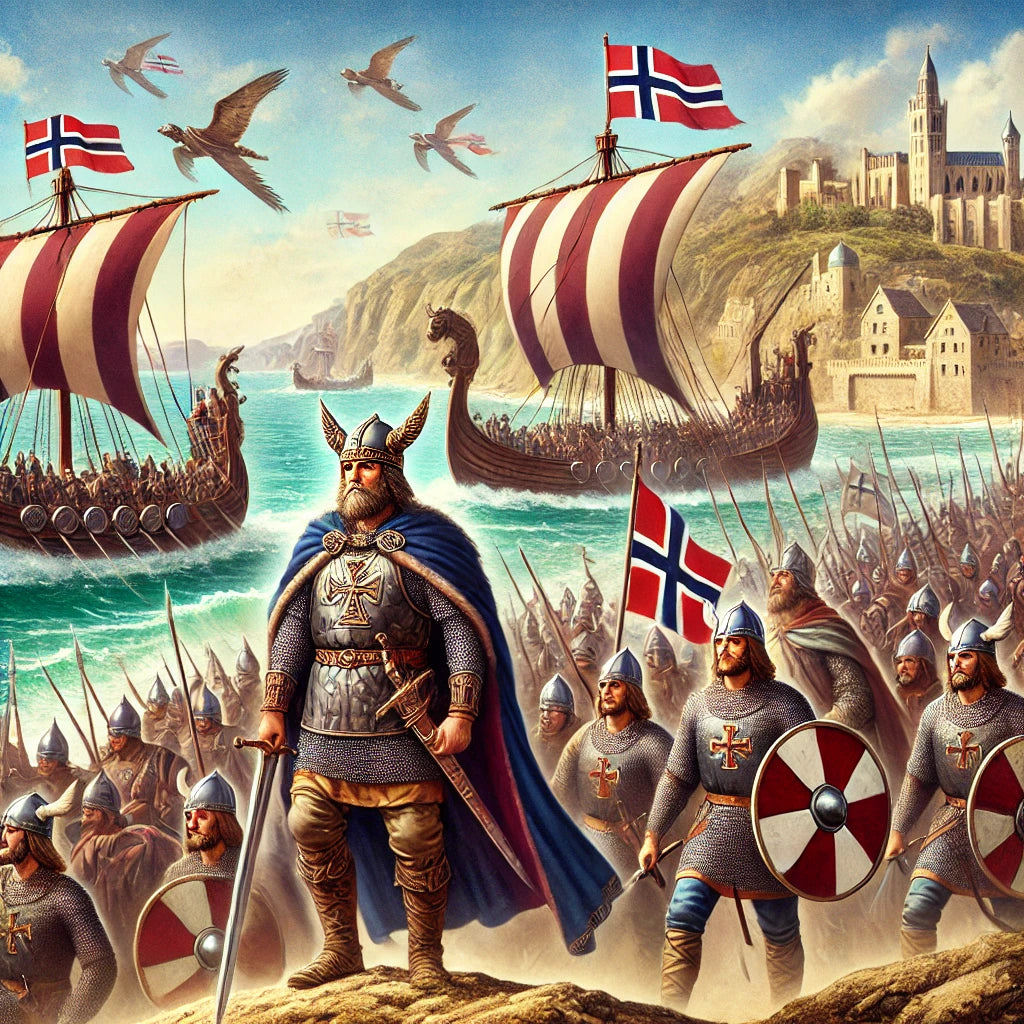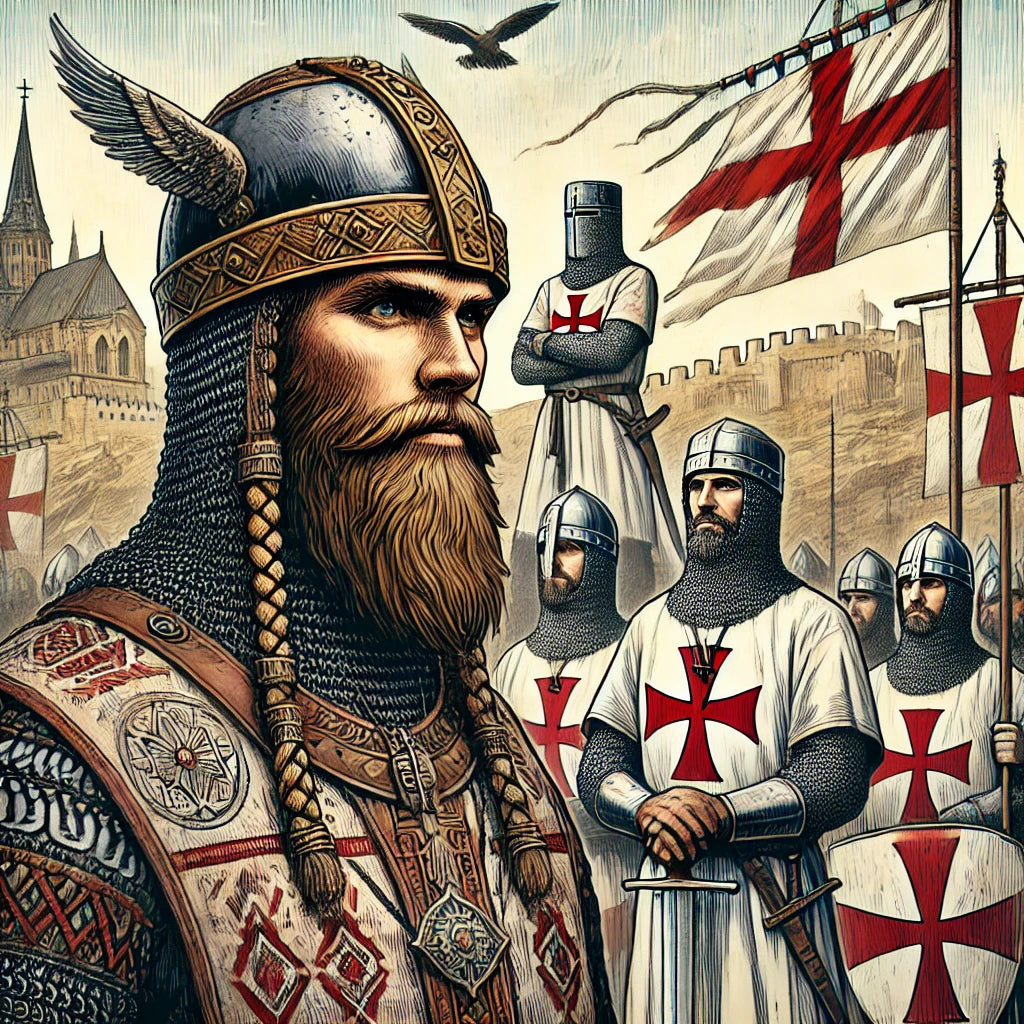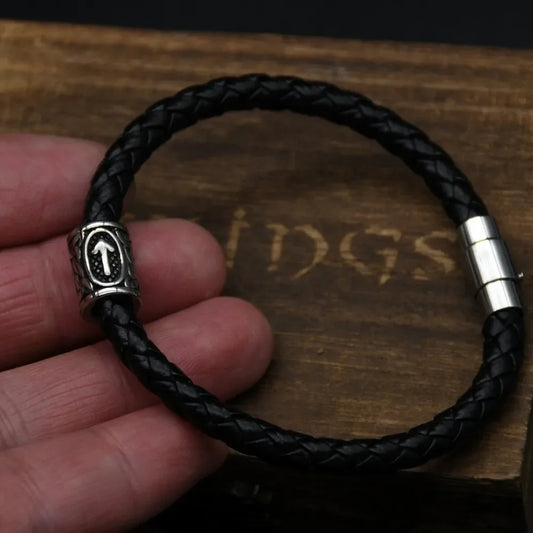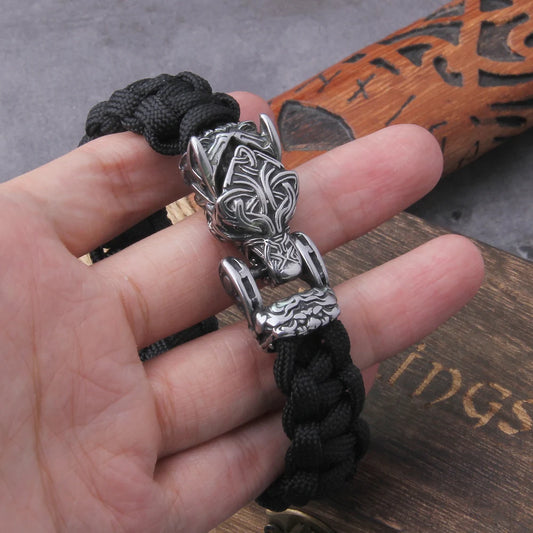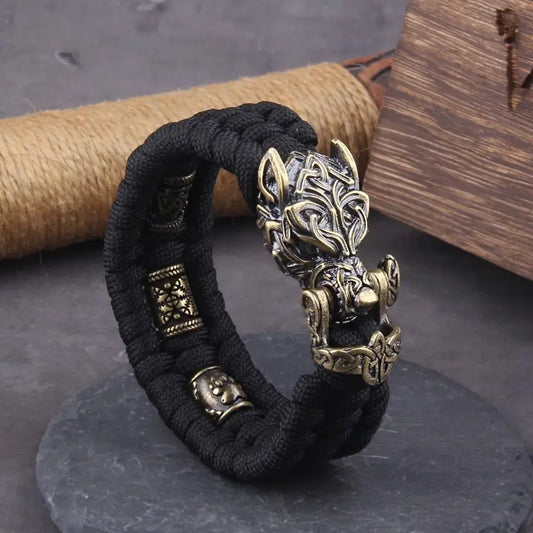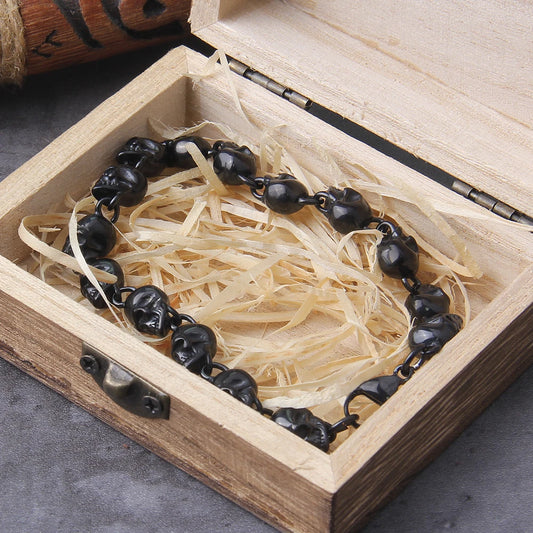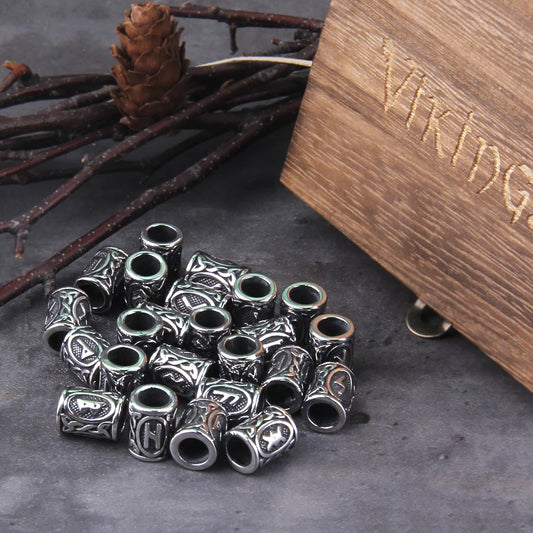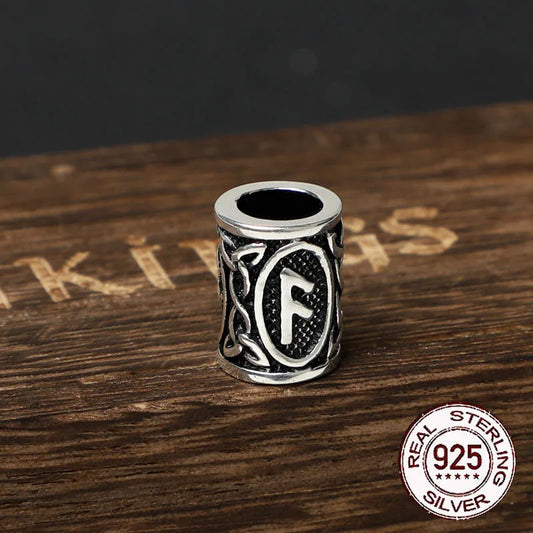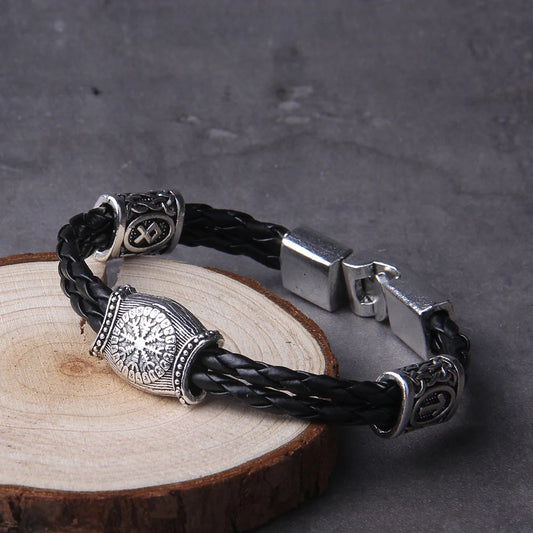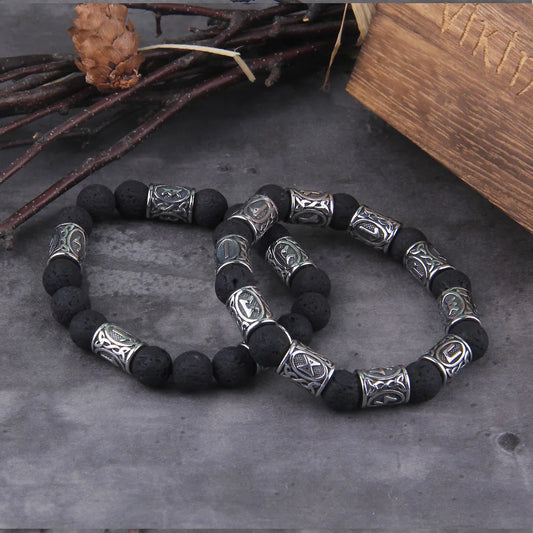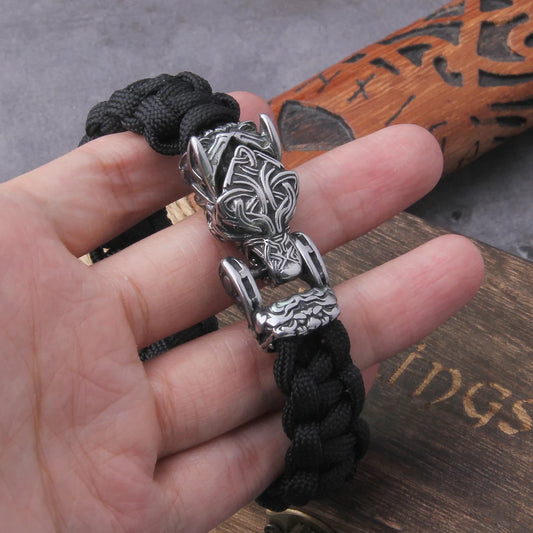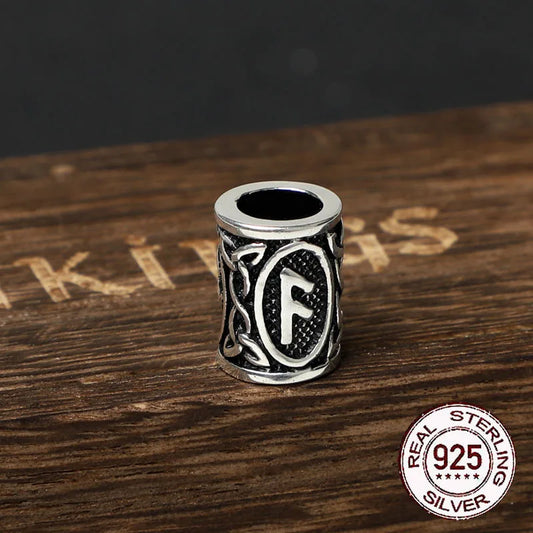Erik Haraldsson Bloodaxe (Eiríkr blóðøx) (c. 895 - 954) was the eldest son of Harald Fairhair and Ragnhild Eriksdatter, daughter of King Erik of Jutland and known as "Ragnhild the Mighty". He was King of Norway c. 931 - 933 and King of Northumberland in the early 950s.
Erik Bloodaxe Early Life
Heimskringla claims that Guttorm was Harald Fairhair's eldest son, named after one of Fairhair's commanders who raised him. Erik was the son who had a mother of royal birth. It was said that he was raised by the war chief Tore Roaldsson in Fjordane.
Erik was known as a great warrior and army man. Already at the age of twelve, according to Heimskringla, he went on a voyage with five longships given to him by his father. He sailed first to the Baltic, around Denmark and south to Frisia, after which he spent four years ravaging Scotland, Ireland, Bretland (i.e. Cumbria or Wales) and Brittany.
At the age of sixteen he sailed north to Finnmark and Bjarmeland (i.e. northern Russia), where he is said to have won a great battle. Indeed, a Fagerskinna poem tells that Erik was received as a great hero by the Norse gods in Valhalla after his death.
At the same time, the saga describes him as a cowardly husband, and although he won some battles, he fled Norway without a fight when his younger half-brother Haakon the Good challenged him. He was also driven from the kingdom of northern England at least once before he fell.
"Erik" was a fairly common name in Sweden at the time, but very rare in Denmark and Norway. Only later did the name become common here as well.
The nickname "Blood Axe" may refer to a killer in general, but blood is also used as a metaphor for kinship and family, and may be linked to him because he had killed several of his relatives.
Erik was by no means the only ruler of his time who fought with his brothers for power; but according to Heimskringla, he and his wife were responsible for the killing of five of his half-brothers, and that was unusual. However, several of those mentioned may not have been his half-brothers at all.
A number of those who were considered sons of Harald Hairy by posterity actually served as his sub-kings, and so one might have thought that they were probably his sons as well, although this was not true.
Some may have been deliberately incorporated into his lineage in the 11th century, so that kings like Olav Tryggvason, Olav Haraldsson and Harald Sigurdsson could legitimise his right to the Norwegian throne by tracing the lineage back to Fairhair's and the assembly of the kingdom.
Others may have been incorporated to compound the impression of Erik's cruelty. The killing of one brother could be considered an accident, while the killing of five appeared monstrous.
Erik Bloodaxe Marriage
On his way north, Erik is said to have met his future queen, Gunhild. According to Ågrip, Fagerskinna and Heimskringla, she was the daughter of Ossur, a chieftain from Hålogaland. Fagerskinna and Heimskringla claim that Gunhild was raised by Sami and trained in sorcery by them. Heimskringla tells that Erik's men in Finnmark came across a gamme (= Sami earth hut), "with a woman so beautiful that they had never seen a mate".
She explained that she was there to learn sorcery from two sorcerers, "the wisest in Finnmark. Now they are out hunting, but they both want me, and both are so skilled that they can follow tracks like dogs, both in mild weather and in frosty weather."
No one escaped them, and everything they shot at, they hit. "If they get angry, the ground turns over when they look at it. And if they set their eyes on anything living, it falls dead." She offered to hide Erik's entourage in the woods, "and we'll see if we can get them killed."
Gunhild then pulled sacks over the heads of the returning wizards while they slept, so that they could not troll; thus Erik and his retinue could kill them. Erik took Gunhild south, but stopped at the coast of Helgeland to ask her father's permission.
In Historia Norwegiae Gunhild is depicted as Danish, a daughter of Gorm the Old and Thyra Dannebod, and Harald Bluetooth's sister. This version seems most credible because it explains why Gunhild and Erik named one of their sons Gorm, a rare name associated with the Jelling dynasty; and why Bluetooth later supported Erik's war campaigns so that Erik's son Harald Gråfeld regained power in Norway, helping to restore Danish supremacy in parts of southern Norway.
Gunhild is described in the sagas as the prettiest of women, but small in stature. At the same time, she is blamed for inciting Erik and later her son Harald Gråfeld to the atrocities they committed. However, the idea of wicked women leading men astray goes back to the Bible's Adam and Eve, and was standard in medieval literature when the sagas were written down.
The story of Gunhild learning sorcery in the north is strikingly similar to the story of Fairhair's one wife, the samepid Snefrid, who bewitched her royal husband, causing him to lose his judgment and authority completely. This is a type of literary repetition typical of the sagas and detracts from their value as historical sources.
The couple had a number of children, but the lists are not consistent. The Orknoe saga tells of the daughter Ragnhild, named after her grandmother, who acquired a reputation as ugly as her mother's.
The sons' names are Harald Gråfeld, Gamle, Guttorm, Erling, Ragnfrød and Sigurd. Also mentioned are Gorm, Halvdan, Gudrød, Øyvind, Sigvard and Gunrød. Some of the names are recognised from lists of Erik's half-brothers, so Erik's sons may have been confused with his brothers.
Erik Bloodaxe Kingship
Erik was handed over the royal power from his father when Harald turned 80, and ruled for the last three years of his father's reign. After Harald Fairhair's death, Norway was divided between the sub-kings, so that Guttorm, the eldest, got Ranrike (between Svinesund and Göta älv), while Bjørn Farmand, Olav, Sigtrygg, Frode and Torgisl got Vestfold, Telemark, Vingulmark (at Oslofjorden) and Raumarike.
Samepigen Snefrid's sons got Ringerike, Hadeland and Toten, while Rørek and Gudrød got revenues from Hordaland and Sogn. Trøndelag was divided between Halvdan the Black (named after his grandfather), Halvdan the Light and Gudrød, while Erik received Sunnmøre, Romsdal and Hålogaland.
The latter is perhaps the origin of the stories that Gunhild came from there. According to the saga, Fairhair wanted Erik to inherit his high seat, and thus Erik was regarded as high king like his father.
Already during Fairhair's lifetime, Erik began to kill his half-brothers. The first killing was Snefrid's son, Ragnvald, who is described as a wizard with eight seidkarle around him. Historia Norwegiae would have it that Ragnvald had learned sorcery from his mother on Hadeland.
Erik made a surprise attack and burned his half-brother and the sextons inside the hall at Hadeland. According to Heimskringla, the people were grateful. It is unclear, however, whether we are meeting a genuine 9th-century reaction to the killing, or whether it is a 13th-century explanation for the fact that the killing of Ragnvald was praised.
It may also be a literary construction in line with the story of Snowfrid's sorcery, but in any case the killing of Ragnvald did not contribute to Erik's later bad reputation.
On the other hand, Erik was strongly condemned for the murder of his half-brother Bjorn Farmand (= Bjorn the Traveller), son of Fairhair and the earl's daughter Svanhild. Bjorn was not a Viking, but a prudent man who traded as king of Westfold.
Heimskringla reports that Erik, on his way home from plundering in the Baltic, bypassed Westfold and demanded that Bjorn provide supplies for Erik's retinue and give them the year's taxes to Fairhair. Bjørn always paid the taxes directly to his father and refused the proposal.
Erik then attacked Bjorn and his men by surprise and plundered the area. Bjorn's brother Olav took over the kingship from Bjorn and raised Bjorn's son Gudrød together with his own son Tryggve.
Next, Erik himself was attempted to be burned at Solve on Møre by another half-brother, Halvdan the Black. Most of Erik's men were killed, but Erik spent the night in another building with four of his retinue and saved his life.
Together with his father, he planned revenge, but others managed to mediate between the parties. Olav ruled at Oslofjorden, and Halvdan controlled Trøndelag.
Two years later he died during a banquet, and Gunhild was accused of having had a witch poison him. Trøndelag did not submit to Erik, however, but instead took another half-brother, Sigrød, as king.
Harald Fairhair lived another year, long enough to pass his name on to the son of Gunhild and Erik who became known as Harald Gråfeld. It was said that Erik would put an end to his rivals, and Sigrød went to Westfold and joined forces with Olavs.
Both were killed in battle, and Erik was now sole king like his father. It was said to have cost five of his half-brothers their lives.
Exile from Norway
Some years later, Erik's younger half-brother, Haakon the Good (Adalstein's Fathers), returned from England. He had been raised there by King Adalstein of England, and "Adalstein's Fathers" was his nickname at the time.
The nickname "the Good" probably came later, as a counterweight to the Earl Haakon the Evil, who ruled Norway under Danish rule in the late 900s. Heimskringla says of Håkon the Good: "Hatred of Erik grew as everyone came to like Håkon and had more courage to speak their minds." Håkon gave the nephews Tryggve and Gudrød the title of king over their fathers' lands and appointed wise guardians to rule when they were still children.
In Trøndelag he gathered a great army and acquired ships. Erik also gathered a force in the west, but the great men supported Haakon instead, and he saw no other way but to flee to the Orkneys.
According to Ågrip and Historia Norwegiae, he fled from England to Spain, where he died during a raiding expedition. Other sources write that he was given Northumberland in fief by King Adalstein, Fairhair's ally, who had fathered Haakon the Younger and in 926 had his sister married to the Viking chief Sigtrygg in Northumberland to secure the alliance with the Vikings in northern England. The sources agree that Erik and his family had to be baptised as part of the deal.
He and his family settled in Jorvik (now York). However, he rampaged around England and Ireland, and was said to have been expelled by King Edmund, brother of the late Adalstein in 941.
English sources, however, do not mention Erik until under King Eadred, another brother of Adalstein. Here it is said that the people of Northumberland rejected Eadred in favour of Yric/Yrk/Hyrc/Eilric/Eiric, i.e. Erik, "of Danish origin" (the Anglo-Saxons did not usually distinguish between Danes and Norwegians).
The choice of Erik as king instead of Eadred was considered treason, and Eadred took cruel revenge. His men even burned down the church in Ripon, although it had been erected by St Wilfred.
As Eadred's forces moved south, men from York followed, killing many in the rear at Castleford. Eadred then threatened to lay waste to Northumberland. The leaders saw no alternative but to expel Erik and surrender to Eadred, who was appeased by the accompanying gift of money.
The various chronicles do not agree on the date, but it is c. 948. One of the manuscripts of The Anglo-Saxon Chronicle claims that Olaf Sithricsson then ruled Northumberland for four years before he too was expelled, and Erik restored as king in 952.
Archbishop Wulfstan of York had approved of Eadred's lordship of the town of Tanshelf on the border with Northumberland, but William of Malmesbury records that the king later had Wulfstan imprisoned because he was in contact with "his friends among the rebels".
It seems that Wulfstan and other leaders in Northumberland preferred a local Viking ruler to being swallowed up by the expanding West Saxon kingdom originating in Wessex.
The destruction of the church at Ripon may also have been the reason for Wulfstan's decision to oppose Eadred; but in 954 Erik was again expelled. Henry of Huntingdon wrote that the people of Northumberland "could not endure a ruler for long, they had accepted Erik, son of Harald - in the third year of his reign they threw him out and invited King Eadred, whom they put on the throne."
Battle of Stainmore
Finally, Erik is said to have been killed by Olaf, one of Edmund's sub-kings, at the Battle of Stainmore against King Eadred in 954. The site is mentioned only in English sources, but as Stainmore lies on the main road across the Pennines (A66), the Roman road linking the west coast of England with Yorkshire, it would be the natural route for Erik on his way to his former kingdom.
Legend has it that he was at the head of a large army, but his opponent's army was so large that for every man killed, three more were added. Erik fell at the end of the day, claiming Heimskringla along with Arnkjell and Erlend, sons of the Orknejar Tørv-Einar, as well as five kings: Guttorm, his sons Ivar and Hårek, and Sigurd and Ragnvald.
Roger Wendover, who wrote Flowers from History in the early 13th century, believes that Eilricus (Erik) was killed along with his sons Reginaldus and Hæricus (Ragnvald and Hårek?) by a nobleman named Maccus. The name form Eilricus may be due to a confusion with the Anglo-Saxon name Ælric.
The sagas believe Erik's killer was Olaf, a king Edmund had appointed to defend the region. This was probably Olaf Sithricsson, for a long time Erik's rival for Northumberland.
Olaf acted partly as sub-king of the kingdom of Wessex and partly as ruler in his own right, but after Erik's death it was Oswulf of Bamburgh who was appointed Earl of Northumberland. The English sources may therefore be right that Olaf was not Erik's killer.
After Erik's death
Gunhild and the children were forced to seek refuge with King Harald Bluetooth in Denmark. According to Heimskringla and the Orkney Saga, they travelled first to the Orkneys, where they took over power from Torfinn Skallekløver, brother of the earls Arnkjell and Erlend, who had been killed together with Erik.
They stayed there for a few winters and from there ravaged Scotland and Ireland in the summers. Here the daughter Ragnhild married Torfinn's son Arnfinn, while Gunhild and the sons continued to Denmark.
The story of Ragnhild's marriage, however, is not found in other sagas, and Snorre Sturlason has not included it in Heimskringla, although there is otherwise a great deal of correspondence between it and the Orknoe saga.
According to the sagas, Gunhild and her sons arrived in Denmark while Harald Bluetooth was king, which he became in 958, four years after Erik's death. With his help, the sons of Erik launched a series of raids to recapture Norway from their uncle, Haakon the Good.
Gamle was killed by Haakon in the Battle of Freidarberg, Guttorm died in a battle in the Baltic Sea, while Sigurd was killed by the mare Klypp in revenge for having kidnapped Klypp's wife.


